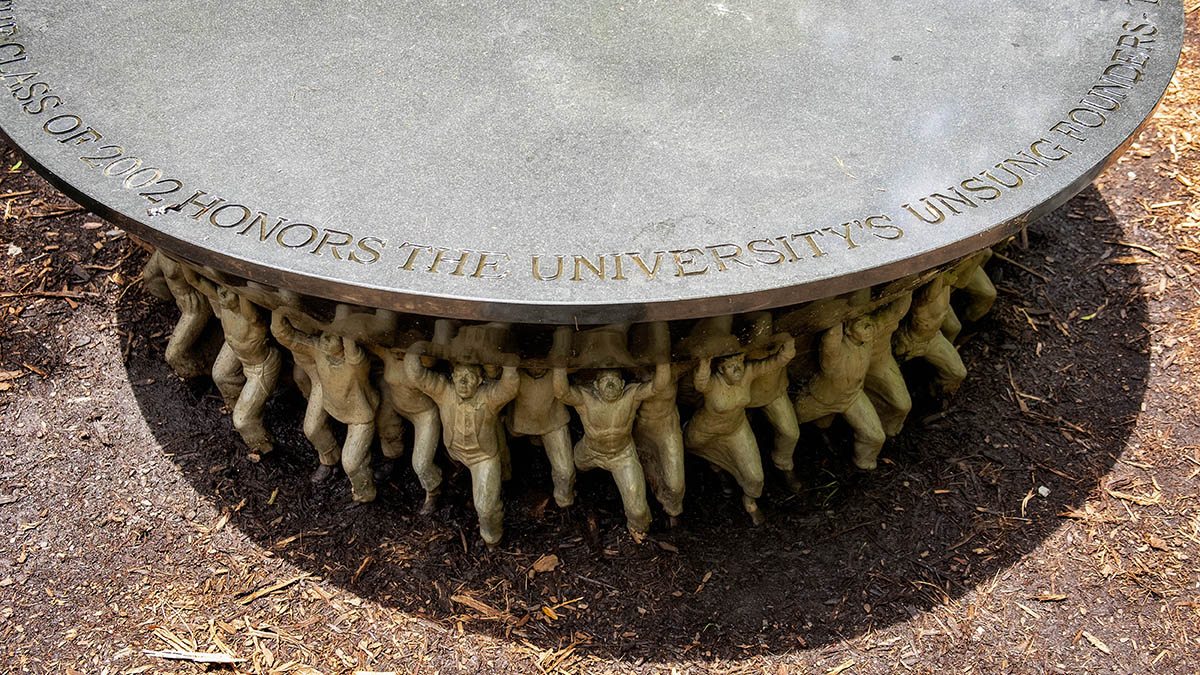The eye of the beholder
For the first time in 20 years, descendants of the enslaved workers the Unsung Founders Memorial was meant to honor heard directly from its originators.

Years of frustration bubbled to the surface during a two-hour webinar about the Unsung Founders Memorial that was sponsored by the University Commission on History, Race and a Way Forward.
“Unsung Founders Memorial: Past and Present” on Oct. 18 brought together members of the community with the some of the memorial’s originators for the first time in two decades, acknowledging a lack of community involvement in the original process that has long been a sore point.
The memorial, a gift from the Class of 2002, in McCorkle Place is a table made of black granite supported by 300 bronze figurines. The table is surrounded by five black stone seats. The inscription around the edge of the table reads, “The Class of 2002 honors the University’s Unsung Founders — the people of color bond and free — who helped build the Carolina that we cherish today.”
The artist and class officers intended the low table — 2 feet tall and 5 feet across — to be a welcoming and interactive counterpoint to the imposing Confederate Monument it shared space with at its 2005 dedication.
But descendants of the workers the memorial is meant to honor and other Black members of the Carolina community see it as a symbol of oppression and belittlement. “I don’t think it’s possible to honor me and make me a footrest,” said Reginald Hildebrand, an emeritus professor of the African, African American and diaspora studies department.
“Why show the unsung heroes still holding, still being oppressed, by this huge stone?” said Delores Bailey, commission member and executive director of EmPOWERment Inc.
“(Our) ancestors were represented by people who were 2 feet tall, that people peed on, changed their babies’ diapers on and put their feet on. It hits us differently,” said Danita Mason-Hogans, commission member and project coordinator of critical oral histories at Duke University’s Center for Documentary Studies. “And those of us who were not invited to the table, I believe, would have added a healthier, heftier conversation piece.”
Good intentions
To get at the intent behind the memorial, the webinar included 2002 senior class Vice President Byron Wilson, who participated as a panelist, and a pre-recorded video presentation and written statement from the artist, Do Ho Suh.
Wilson is the owner of Empty Set, a design consultancy for health care organizations and research and development labs. He was recently profiled as part of a documentary about Black alumni of ArtCenter College of Design in Pasadena, California.
In 2001-02, he and class president Ben Singer were struck by the contrast between campus buildings bearing the names of slaveholders and the unmarked graves of enslaved workers. “We had a feeling that something should be done to honor the dead,” Wilson recalled. After “intense conversation,” they decided to put the idea of a memorial honoring those workers on the ballot to choose the class gift to the University. “It was our first foray into public art.”
The memorial received the most votes, and the senior class eventually raised $54,000 to purchase it, a gift later matched by the Chancellor’s unrestricted fund to complete the funding of the memorial and its placement.
Based on recommendations from art department faculty and examples of his work, they chose Suh, a South Korean-born sculptor and installation artist known for his anti-monuments. The artist intentionally did not put the Unsung Founders figures on a pedestal, which he considers a symbol of “colonial power.”
“By bringing the memorial down to beneath eye level I hope to rearticulate the relationship between the object and the public,” he said in his written statement. “When you look down, you see the actual site, the grass and the earth, and the mass of figures that symbolize the multiple, diverse, often unnamed, people who constructed the walls of the surrounding buildings.”
Community reaction
Community members, while expressing appreciation for the artist’s vision and the class officers’ intentions, said they believed the University erred in not seeking input from community members during the process, including how such an anti-monument might be viewed by them.
“Valid as it may be as a piece of art, if it doesn’t commemorate or memorialize in a way that people understand, something has failed,” Hildebrand said.
Mason-Hogans specifically did not blame the students but the University for its lack of inclusivity in the process. “The onus was on the University of North Carolina at Chapel Hill to recognize and come up with a way to honor people like my ancestors who, literally, with blood, sweat, tears and black bodies built this university,” she said.
Other memorials that were not well received at first can grow in acceptance, pointed out commission member Joseph Jordan, vice provost for academic and community engagement and director of Sonja H. Stone Center for Black Culture and History.
The Vietnam Veterans Memorial, for example, was “bitterly disputed by a number of veterans who felt that there weren’t enough figurative elements to it,” Jordan said of the black granite wall engraved with the names of fallen soldiers. “If you go there today, it is still one of the most moving sites you can visit in the capital.”
The webinar was the first in a series about the Unsung Founders Memorial. The next webinar will focus on the memorial’s future. In its current location, the memorial is sinking into the ground because of rain and erosion, and there is a plan to refurbish the site. The memorial has also been the target of pro-Confederate protestors, including two who were arrested in 2019 for vandalizing it.
A date has not been set for the second webinar, but it will be announced on the commission’s website.




